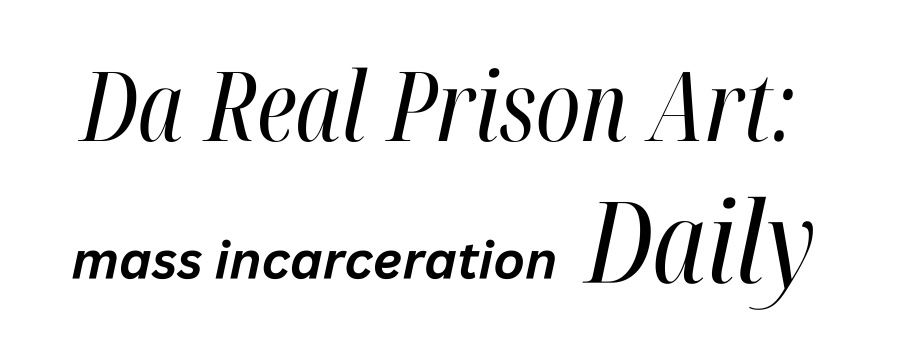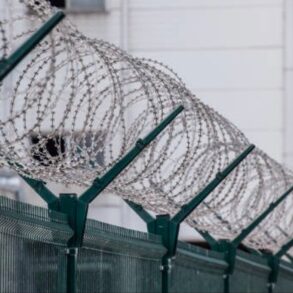Jackie Snow reflects on what working for a books-to-prisons nonprofit has taught her about reading.
:quality(75)/https%3A%2F%2Fassets.lareviewofbooks.org%2Fuploads%2FLonesome%20Dove.jpg)
ABOUT A MONTH after Donald Trump was elected president the first time, I finally made my way to DC Books to Prisons. I had been meaning to go to one of the group’s monthly orientation meetings, but the emotional fallout from the election pushed me to action. In December 2016, I descended the steps into the church basement where the nonprofit, which sends free books to incarcerated people across the country, had made its home.
After a quick introduction from a soft-spoken volunteer named Susan on how the nonprofit operates—you read the letters incarcerated folks write to the group, look through the shelves of donated books to find the titles that most closely align with the request, and write a short reply—I was let loose to tackle an overflowing box of letters.
I don’t recall any of the letters I answered that night, but I knew after my first shift that I would be back. I vibrated with the feeling of rightness. I was reading close to 100 books a year, so I had the knowledge base. I had tried to find a place to volunteer for years but floundered at each attempt; the fit never worked for a variety of reasons. But I could do this. I would be helpful in a world that suddenly felt hopeless.
Eager, I threw myself in, quickly learning that sending books to prisons required enthusiasm as well as substantial knowledge about prisons, censorship, the postal service, and a wide range of literature. The latter became apparent when I realized that regularly requested genres such as thrillers, westerns, and romances were blank spots in my reading history. To better answer these letters, I began reading popular genres, a self-assigned homework project that eventually upended my own beliefs about literary merit and changed who I was as a reader, writer, and person.
The thousands of letters I’ve read since that first day in 2017 made me confront my own literary prejudices. While many readers everywhere—regardless of their circumstances—happily read what genuinely interests them, I had unconsciously limited my own literary choices within invisible walls of cultural approval.
This recognition didn’t come from any special wisdom from incarcerated readers but from my continued exposure to an approach to reading that operated outside my familiar framework. My reaction to the writers’ requests—straightforward expressions of literary interest uncomplicated by concerns of cultural prestige—revealed how thoroughly I had internalized the idea that some books were more “worthy” than others.
Letter after letter showed me a refreshing disregard for that invisible tyranny of taste determining what we “should”—even “must”—read. Many incarcerated readers, like countless readers outside prison walls, simply request books that speak to their interests. There’s no performance of literary sophistication, just an authentic desire for stories that resonate, entertain, and provide pleasure.
¤
Friends and family typically can’t send books directly to their loved ones inside. Instead, prisons require books to come from “approved vendors,” often specialized book services with marked-up prices, or sometimes from Amazon, which, while somewhat more affordable, remains financially out of reach for many families already strained by the costs of having a loved one in prison.
And then there is us—the third option, a network of volunteer-run book-to-prison programs sending free reading materials on shoestring budgets. DC Books to Prisons, now in its 26th year, is one of several dozen similar organizations across the United States and Canada that bridge this gap, ensuring that reading materials reach those who would otherwise go without, no matter how labyrinthine the regulations.
And labyrinthine they were. Even before the letters disabused me of my literary blinders, I discovered an entire universe of rules governing the process of getting books inside prisons. Learning the regulations felt like studying for a degree in carceral bureaucracy, complete with surprise pop quizzes and midsemester syllabus changes.
Some rules were relatively straightforward: certain subjects—like lock-picking, psychological manipulation, or martial arts techniques—simply couldn’t enter most facilities, so we didn’t keep them on our shelves. That was easy (and obvious) enough.
But then came the vast gray territory, a landscape of perpetual negotiation. We rarely kept Tai Chi books, worried that it would be connected to martial arts despite the practice’s gentle flowing movements. Why waste precious volunteer hours and postage when we could send a yoga book instead? “Gang-related” material was prohibited, but what about The Godfather (1969)—literally one of the most celebrated novels about organized crime in American literature?
Nudity deserved its own separate category of censorship anxiety. We once had a book returned because it contained an image of the infant Jesus without clothes. Anatomy textbooks were automatic rejections because of genital diagrams. We maintained a special reference list documenting which National Geographic issues contained Indigenous peoples in traditional dress that would prevent the magazines from entering certain facilities. I spent an embarrassing amount of time studying a photo in Colin Powell’s autobiography—a picture of the future statesman as a baby, lying on his stomach with the curve of his infant bottom in soft focus. I found myself scrutinizing this completely innocent image, trying to calculate whether a prison mail room would find it objectionable.
More than 90 percent of our books were donated by DC residents after they’d finished reading them. But even the most benign pencil mark could trigger rejection. Deciding what constituted “acceptable” marginalia was more art than science—a calculus involving the book’s rarity, the specific facility’s reputation, and the intensity of the underlining.
Was it a dog-eared Stephen King—an author perpetually showing up in our donation bins yet somehow never meeting the demand from readers inside—headed to a facility known for reasonable mail inspections? I’d risk it. An exceedingly rare but incredibly popular “urban novel”—a genre usually written by Black authors, with an unflinching view of street life that might include topics that prisons frowned upon, such as selling drugs or gun violence—destined for a prison infamous for its rigid interpretations? Unlikely, but depending on the day, I might still risk the postage. Behind every rejection lurked the same institutional paranoia: hidden messages, drugs, or seeds of discontent that might blossom into unrest concealed within innocent pages.
Hardcovers were typically rejected—the covers could be sharpened into weapons or used for body armor, we were told—but they were also more expensive to send through the mail. Some facilities, however, like the California prison camps for incarcerated firefighters, accepted whatever format we sent them. “Lady, we give these guys axes,” one prison mail-room worker in California told another volunteer who called to inquire. “We aren’t worried about hardcovers.”
Water damage was another major concern—officials feared that pages might have been dipped in liquid drugs. Not only did they want to keep substances out, but they also worried about mail-room staff being exposed to fentanyl. By every credible account I’ve read, fentanyl doesn’t work this way. Still, prison officials would sometimes claim that they suffered exposure from merely handling letters.
These ever-shifting rules and changing interpretations made each package a gamble. What passed inspection last month might be rejected today. What one facility accepted, another banned outright. This patchwork of regulations was particularly challenging when serving readers beyond our usual territory.
Washington, DC, has no prisons, so any local resident who winds up incarcerated could be sent to federal facilities across the country. Even when we received letters from facilities we didn’t typically serve, we’d make exceptions for DC residents (identifiable by their inmate numbers). This was something tangible we could do for our former—and likely future—neighbors.
According to the Sentencing Project, almost 85 percent of people in prison in the United States will eventually reenter society, and even for the approximately 200,000 people serving life sentences, reading materials can improve mental health and well-being. That’s beneficial for everyone inside the facility, something that even the most pro-incarceration thinker should recognize. And yet, getting books inside—I have barely scratched the surface here on the rules, not to mention the packaging requirements of some prisons—only got more convoluted.
¤
This straightforward approach to reading takes on additional significance in our current moment, as the second Trump administration pursues an unprecedented expansion of the prison system. The CEO of private prison giant CoreCivic recently celebrated what he predicted to be “the most significant growth in [the] company’s history”—an expansion coinciding with always-tightening restrictions on what incarcerated people can access.
The numbers are staggering: over 50,000 books are already banned in state prisons across the United States, according to a 2023 report by the Marshall Project. This figure, based on lists provided by just 19 states, likely underestimates the true scale of literary censorship in American prisons. Florida alone prohibits 20,000 books, while other states maintain inconsistent and often arbitrary restrictions.
But even when books are technically accessible, many facilities have supplanted physical books with digital tablets—a development that comes with its own barriers. Prison telecommunications companies like Global Tel Link (GTL) and JPay charge incarcerated readers up to five cents per minute to access digital content, including books in the public domain that are free to everyone else. This predatory practice transforms reading from a right into a commodity, disproportionately affecting slower readers in what amounts to a tax on literacy itself. Katy Ryan, founder of the Appalachian Prison Book Project—another volunteer organization that sends free books to people imprisoned in six Appalachian states—has done the math and found that reading a single novel like Nineteen Eighty-Four (1949) costs approximately $20. Meanwhile, imprisoned people’s wages, if they’re paid at all, are typically less than one dollar per day.
Incarcerated individuals retain constitutional rights that don’t disappear at the prison gate, including First Amendment protections. The Supreme Court affirmed this in its 1989 ruling in Thornburgh v. Abbott, which requires prison officials to make individualized assessments of reading materials rather than implementing blanket bans. Yet across the country, vague security concerns routinely override these protections, with minimal oversight or accountability.
¤
The letters arrived with requests that eventually became a predictable pattern to me. A request for a dictionary—the most sought-after book—would arrive every few letters. Thrillers came at an even more consistent beat, probably every other letter. Requests for African American history, Native American history, true crime, or Westerns emerged every 20 requests, rarer but regular enough to predict. Letters ranged from requests for specific titles that ran pages long to lists of genres on a scrap of paper.
Between those expected messages, letters could be anything, turning me into a research librarian. Klingon dictionary requests showed up a few times a year (sometimes rejected because prison officials didn’t want incarcerated Star Trek fans to be able to communicate secretly). Transgender women wrote in a couple of times looking for books on vocal feminization. I had a mom in Kansas send us stamps and a brief letter asking for a book on helping children with ADHD. Requests for what I called the white-power trilogy showed up every so often—books on Norse, Celtic, and Viking history. I tried to give those requests the benefit of the doubt, seeing lots of letters from people trying to connect to their roots in prison, and sent along factual (but often dry) histories.
My background in more literary fiction did occasionally come in handy. Once, I had someone ask for Zora Neale Hurston, one of my favorite writers. We didn’t have any of her work available, so I sent Flannery O’Connor instead, letting the reader know it was another Southern woman writer with a distinctive voice.
The new reading project began within weeks. Thrillers and mysteries were the easiest entry point. I borrowed some from our shelves, immediately understanding the appeal of Jack Reacher. I moved through Val McDermid, Walter Mosley, Randy Wayne White, and Tana French with growing appreciation.
The Westerns we received came in batches, and we morbidly assumed these were donations after beloved grandfathers had died. A book that showed up on its own occasionally was Larry McMurtry’s Lonesome Dove (1985). Despite its Pulitzer Prize win and numerous other accolades, I had never read McMurtry’s most famous novel, or anything at all by him. I inhaled it, riding along the trail with Call and Gus, recognizing what many others know—that Westerns are a metaphor for American identity itself, warts and all.
I’ve since convinced others to read the novel, and I’m making my way through McMurtry’s extensive catalog. But that wasn’t enough. During a 2024 trip to Waco, Texas, for the April solar eclipse, I made a side trip to Hotel 1928, where thousands of books from McMurtry’s former used bookstore in Archer City—handpicked by HGTV stars Chip and Joanna Gaines—have found a new home.
My librarian friend tsk-tsked at how they were stored: leaning, stacked in ways that put stress on the spines. Some still had scraps of paper tucked inside and prices scrawled in pencil at the top corner of the title page, in what I assumed was McMurtry’s own handwriting. These volumes, once offered to anyone with a few dollars in McMurtry’s dusty shop, now served as set dressing. Meanwhile, less than an hour away in Gatesville, Texas, multiple prisons dotted the landscape—facilities to which I had sent plenty of packages over the years.
This proximity made the disconnect impossible to ignore. At Hotel 1928, books were treated as decorative objects amid a crowd that mostly ignored them, while 40 miles away, there were readers who would cherish these same tomes if given the chance. I felt like a living link, moving between them with a freedom neither the books nor their potential readers possessed.
¤
But perhaps no genre has been more transformative for me than romance. Though the best-selling category in the outside world wasn’t as popular inside—it’s a genre primarily written for women by women, and most people in prison in the United States are men—it appeared in enough requests that I needed to understand it. Romance presented unique challenges: most prisons prohibit sexual content, but modern covers, with their cheerful illustrations, offered few clues about what lay between the pages, unlike the obvious clinch covers of the 1990s.
This disconnect created opportunities for small rebellions. Where explicit books like 50 Shades of Grey (2011) would be rejected immediately, equally “spicy” titles with cartoony, innocent-looking covers might slip past inspection. My research—which quickly became genuine enjoyment—equipped me to become a literary smuggler of sorts, matching readers with books whose heat levels I now knew intimately. I couldn’t stop reading them.
My romance reading began somewhat secretly, which mirrored many requests we received. Readers asking for romance, or sometimes erotica, often tucked these titles carefully into the middle of longer lists of more “acceptable” genres like nonfiction and dictionaries—burying their desires.
Learning that bell hooks read two Harlequin novels daily demolished whatever literary pretensions I still harbored. Romance novels, as hooks noted in 1999, tell stories where, no matter what obstacles the protagonists face, they “will triumph over it and it will all come right in the end.” These narratives center relationships and guarantee happy endings—why not embrace something joyful that celebrates love in all its forms?
This recognition eventually led me to write a romance novel of my own, transgressing the boundaries of what I, a “serious” journalist, was supposedly permitted to produce. Sneaking in 500-word increments after completing nonfiction assignments, I completed the manuscript in just over a year. While discussing a proposal for a Serious Nonfiction Book with an agent who had expressed interest, I gathered the courage to ask if she might consider representing my romance novel too.
After reading the first third of the manuscript, she said yes—an endorsement that felt like validation of my new, broader literary identity. The walls between “serious” and “popular” work had fallen, not just in my reading life but in my writing life as well.
¤
What our incarcerated readers demonstrate is that true literary autonomy isn’t about reading “better” books—it’s about the fundamental right to read freely to pursue pleasure rather than prestige, to seek what speaks to our individual humanity rather than what serves institutional expectations.
This truth became even more evident when prison officials suggested we send books to the facility library instead of directly to individuals. As any reader knows, there are books we don’t lend out—books that hold personal significance, that become extensions of ourselves. The prison library, while valuable, can never replace the intimate relationship between a reader and their own book, chosen freely and held close. Facilitating this connection remains the core mission that keeps us going, despite mounting challenges.
Last year, DC Books to Prisons answered more than 7,000 letters. I read 203 books, probably half of them romance novels, but there was one McMurtry and at least three thrillers too. Though I’ve moved to Los Angeles, I remain connected—I bring books during visits to DC, and I stay on their national LISTSERV, where I witness, with growing concern, volunteers sharing news of more facilities implementing stricter topic restrictions or blocking access to books entirely. These new barriers, emerging in the early months of the second Trump administration, echo the pattern of expanding control that his administration outlined in its ambitions for prison growth.
Yet despite these challenges, more volunteers have stepped up. The letters continue to arrive in the church basement, each one a testament to the persistence of literary desire in the face of tightening restrictions. They remind us that reading, at its core, isn’t about cultural capital or carceral control. It’s about maintaining our essential human right to imagine differently, to choose freely, and to find joy in our own way, even within confinement. In sending books across these barriers, both the letters and I have crossed our own. The right book always finds its reader, eventually—some just require more help getting there.
LARB Contributor
Jackie Snow is a journalist published by The New York Times, National Geographic, The Wall Street Journal, and other outlets.
Share
LARB Staff Recommendations
-
Annie Buckley describes her experiences working with incarcerated artists via the Prison Arts Collective.
-
Sterling Cunio shares an excerpt from his recent book, “The Sentences That Create Us: Crafting a Writer’s Life in Prison.”
Keep LARB free and flourishing!
Join us in defending the future of critical conversations on literature, culture, and art by getting your membership matched by the Whiting Foundation today.
This post was originally published on this site be sure to check out more of their content.





